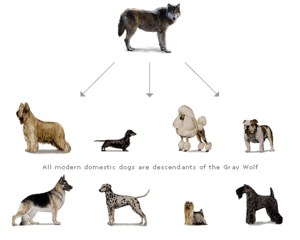Evolution of Dog Breeds: Difference between revisions
| Line 6: | Line 6: | ||
==Genetics== | ==Genetics== | ||
Genetic analysis and research has found that because of domestication there came to be a relaxation of typical selective forces of natural selection (survival of the fittest). Rather, dogs were selected for traits that, in the wild, would make them less fit for survival. Modern domestic dogs also have greater variability in their genomes than in their ancestral counterparts. Interestingly, genetic variation within the <i>Canis familiaris</i> (dog family has different breeds with a wide range of phenotypes) is greater than variation between different species in the entire family of Canidaes <ref>[https://www.nature.com/scitable/topicpage/genetics-of-dog-breeding-434/ Adams, J. "Gemetics of Dog Breeding." 2008.]</ref>. | Genetic analysis and research has found that because of domestication there came to be a relaxation of typical selective forces of natural selection (survival of the fittest). Rather, dogs were selected for traits that, in the wild, would make them less fit for survival. Modern domestic dogs also have greater variability in their genomes than in their ancestral counterparts. Interestingly, genetic variation within the <i>Canis familiaris</i> (dog family has different breeds with a wide range of phenotypes) is greater than variation between different species in the entire family of Canidaes <ref>[https://www.nature.com/scitable/topicpage/genetics-of-dog-breeding-434/ Adams, J. "Gemetics of Dog Breeding." 2008.]</ref>. | ||
[[Image: PhylogeneticDogTree.png|thumb|300px|right|A phylogenetic tree of dog breeds.]] A phylogenetic analysis of 736 base pairs (bp) of the cytochrome <i>b</i> gene showed that gray wolves are the only direct ancestor to the domestic dog with dog-wolf sequences differing in only about 0-12 substitutions <ref>[https://academic.oup.com/jhered/article/90/1/71/2187103 Vilá, C. et. al."Phylogenetic relationships, evolution, and genetic diversity of the domestic dog." 1999.]</ref>. | [[Image: PhylogeneticDogTree.png|thumb|300px|right|A phylogenetic tree of dog breeds.]] <br> A phylogenetic analysis of 736 base pairs (bp) of the cytochrome <i>b</i> gene showed that gray wolves are the only direct ancestor to the domestic dog with dog-wolf sequences differing in only about 0-12 substitutions <ref>[https://academic.oup.com/jhered/article/90/1/71/2187103 Vilá, C. et. al."Phylogenetic relationships, evolution, and genetic diversity of the domestic dog." 1999.]</ref>. | ||
==Microbiome== | ==Microbiome== | ||
Revision as of 19:25, 4 November 2019
Introduction
The evolution of dog breeds is an interesting story of human involvement in the domestication of a wild animal, the gray wolf. The domestic dog is called Canis familiaris. The artificial selection of dog breeds has led to diversity in size, conformation, and pelage seen today in domestic canines[1]. The dog evolved approximately 12,000-15,000 years ago when early humans domesticated animals and plants for farming during the Stone Age.
There are different views on how dogs evolved- was their evolution due to humans selecting animals for domestication, or was it that the animals had to evolve because they were in a new ecological niche (co-existing with humans in a domestic setting)? [2] Through phylogenetic analysis of dog and gray wolf mitochondrial DNA (mtDNA) sequences, it was found that domestic dog sequences are found in at least four distinct clades, implying a single origination event and at least three other origination or interbreeding events [3]. Further studies have concluded that domestic dogs originated in Siberia and migrated into the Americas, Asia, and the rest of Europe[4].
From the evolution of the domestic dog, there is the evolution of the modern dog breeds. The American Kennel Club (AKC) recognizes 193 of the 340+ dog breeds in the world [5]. Many dogs are bred for specific tasks or characteristics/traits. For example, there are hunting/game dogs, guard dogs, herding dogs, and companion dogs. The AKC has lists on standards for ideal pure-bred traits ranging from temperament to physical appearance to movement and gait. With human evolution and sophistication came breeding sophistication and evolution. Dogs were bred and selected for "desirable traits" leading to the modern dog breeds of today [6].
Physical Evolution
Current research in the physical evolution of dogs includes insight that the evolution of facial features of domestic dogs, more specifically "puppy dog eyes", has occurred within the past couple centuries to better communicate with humans. The research found that dogs have evolved new muscles around the eye that can raise their eyebrows.
Dogs specifically has evolved to raise their inner eyebrows. The scientists and psychologists on the research team believe that by raising their eyebrows, dogs are making their eyes appear larger and more infant like[7].
Behaviorists, anatomists, and comparative psychologists found that the dogs raised their inner eyebrow more and at higher intensity than wolves when exposed to a human for 2 minutes. Furthermore, the research found that "puppy dog eyes" could be the result of unconscious decisions when breeding dogs. In other words, the ability to raise the inner eyebrow was a desirable trait when breeding dogs, and therefore the evolution is supplemented by the result of selection[8]. Dogs could have also evolved because of their increase in human contact and need to mimic human facial expressions.
The evolution of certain dogs' physical appearance is due to selective breeding where the desirable appearance is bred with another dog of the same appearance to create offspring with that same desirable feature. Continuous lines of breeding lead to pure-bred lineage, much like bloodlines in royal families.
Genetics
Genetic analysis and research has found that because of domestication there came to be a relaxation of typical selective forces of natural selection (survival of the fittest). Rather, dogs were selected for traits that, in the wild, would make them less fit for survival. Modern domestic dogs also have greater variability in their genomes than in their ancestral counterparts. Interestingly, genetic variation within the Canis familiaris (dog family has different breeds with a wide range of phenotypes) is greater than variation between different species in the entire family of Canidaes [9].
A phylogenetic analysis of 736 base pairs (bp) of the cytochrome b gene showed that gray wolves are the only direct ancestor to the domestic dog with dog-wolf sequences differing in only about 0-12 substitutions [10].
Microbiome
Include some current research, with a second image.
Conclusion
Overall text length should be at least 1,000 words (before counting references), with at least 2 images. Include at least 5 references under Reference section.
References
- ↑ Vilá, C. et. al."Phylogenetic relationships, evolution, and genetic diversity of the domestic dog." 1999.
- ↑ Morey, D. "The Early Evolution of the Domestic Dog." 1994.
- ↑ Ostrander et. al. "The Canine Genome." 2005.
- ↑ Leathlobhair et. al. "The Evolutionary History of Dogs in the Americas." 2014.
- ↑ "Dog Breeds." 2019.
- ↑ "Dog Breeds." 2019.
- ↑ Kaminski et. al. "The Evolution of Puppy Dog Eyes." 2019.
- ↑ Kaminski et. al. "The Evolution of Puppy Dog Eyes." 2019.
- ↑ Adams, J. "Gemetics of Dog Breeding." 2008.
- ↑ Vilá, C. et. al."Phylogenetic relationships, evolution, and genetic diversity of the domestic dog." 1999.
Edited by Tillie Wang, student of Joan Slonczewski for BIOL 116 Information in Living Systems, 2019, Kenyon College.



